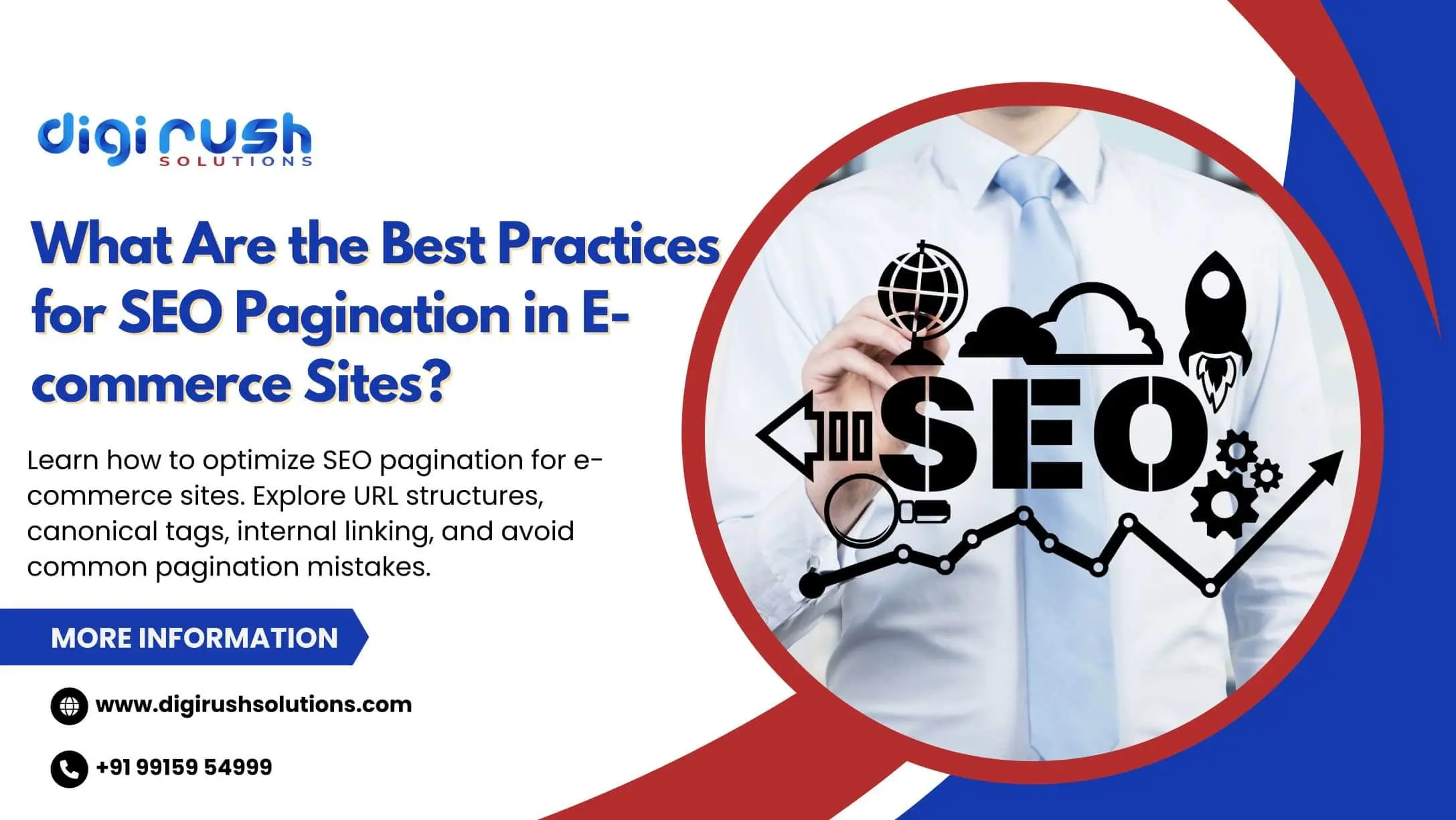
E-commerce websites often face the issue of managing enormous quantities of content when listing products. When you list hundreds—if not thousands—of products under one category, it can quickly become overwhelming to display all that information on one page. Most users are not going to scroll through thousands of products on one page! That's where SEO pagination is proper.
Pagination allows you to chunk up content so it's easier to manage and use. Using pagination can enhance usability as well. However, if pagination is done poorly, it can confuse search engines, create issues with duplicate content, and impact rankings. This is why knowing how to use SEO pagination and best practices properly is so vital for all e-commerce websites to achieve optimal visibility in search and a quality user experience.
Let's look at some of the key components of effective pagination in SEO and how e-commerce websites can best utilize it.
Why SEO Pagination Matters in E-commerce
Search engines depend on an organized and transparent framework for crawling content and adding it to their index. Problems arise when pagination is poor, including:
- Duplication or thin content distributed across pages
- Wasting your crawl budget
- Indexing critical products or categories improperly
- Bad internal linking and through experience
Online retailers rely heavily on category and product listing pages. Therefore, pagination is not merely about separating content into pages; it is about a structure that can easily be understood and navigated by both search engines and users.
Even prominent digital service owners, like an SEO Agency in Jaipur, underline the importance of a pagination strategy to enhance technical optimisation for retail clients.
Common SEO Pagination Mistakes to Avoid
Before we start talking about the ways you can help improve your practice, let’s first address some of the most common mistakes that ultimately undermine your site performance:
- Noindexing to Paginated Pages: The first and most common mistake is noindexing your paginated pages, believing they are either duplicates or low-value. Ultimately, either scenario means you will not even index important content (like products).
- Canonical Tags Pointing to Page 1: Using a canonical tag to point every page in a paginated set to the first page of the particular series is misleading and inaccurate for search engines. Suppose you say you canonicalized every page to point to the first page. In that case, you are telling search engines that page 1 is the only page you want to represent in search, in turn taking away ranking opportunities from every other paginated page.
- No Internal Linking Between the Pages: If you cannot move smoothly to the next page or previous page, that may be one of the pagination links (next, last), which reduces the quality of the crawlability for both search engines and user experience.
- Infinite Scroll without a fallback: Some sites commit to infinite scroll without having a paginated version for search engines. And while endless scroll is wonderful for users, it can often be SEO suicide without the proper handling.
Best Practices for Implementing SEO Pagination
To ensure both usability and search engine friendliness, follow these best practices for SEO pagination on e-commerce websites:
1. Use Clean and Descriptive URL Structures
Paginated URLs should be simple, logical, and consistent. For example:
This kind of SEO pagination URL structure is easy to understand for both users and search engines. Avoid messy or overly complex URLs with unnecessary parameters.
Tips:
- Always include the page parameter (e.g., ?page=2).
- Don't use session IDs or tracking parameters in paginated URLs.
- Maintain keyword consistency across paginated URLs.
Many technical teams, including those from a reliable web development company in India, focus on this detail to enhance indexability and crawl efficiency.
2. Include Self-Referencing Canonical Tags
Each paginated page should have a canonical tag that points to itself, not just to the first page. For example, page 2 should use:
This ensures each page is treated as unique and valuable. Incorrect canonicalization can lead to poor indexing or Google ignoring your paginated content entirely.
3. Ensure Proper Internal Linking Between Pages
Use "Next" and "Previous" links to guide both users and search engines through your content.
Although Google has officially stated that it no longer uses rel="next" and rel="prev" as indexing signals, these still help structure your HTML and improve user experience.
More importantly, visibly include pagination links on your web pages. Users should be able to jump between pages easily, and search engine crawlers benefit from this interconnected structure too.
4. Avoid Duplicate Titles and Meta Descriptions
Each paginated page should have unique titles and meta descriptions. This improves relevance and click-through rates in search results.
Example:
- Page 1 Title: "Men's Running Shoes - Buy Online | BrandName"
- Page 2 Title: "Men's Running Shoes - Page 2 | BrandName"
While the content may be similar, a unique title helps search engines understand each page's purpose.
This practice is frequently emphasized by consultants in agencies such as an SEO Agency in Pune, who help fine-tune metadata for better SERP performance.
5. Use Structured Data Correctly
If your e-commerce site uses structured data (like schema markup), ensure it's handled adequately on paginated pages.
For example:
- Only include the Product schema for items shown on that specific page.
- Avoid including the same Breadcrumb or ItemList data across all paginated URLs.
This avoids misleading Google about what products are available on each page.
6. Don't Block Paginated Pages in Robots.txt
Some site owners attempt to hide pagination URLs from being crawled, thinking they cause duplicate content. However, this blocks essential products from being indexed.
Allow search engine crawlers to access paginated URLs freely. If you must limit crawl depth for performance reasons, use crawl delay settings or limit pagination depth in a logical way (like linking to only the first five pages).
7. Optimize Load Speed and Mobile Experience
Paginated pages should be as fast as your primary category pages. If page 5 loads slower than page 1, users may abandon your site.
Make sure:
- Images are optimized
- Server response time is low
- Pages are mobile responsive
Especially on mobile, small pagination buttons or an inconsistent design can hurt usability and increase bounce rates.
8. Provide a View-All Page (If Feasible)
A "view all" option can sometimes enhance usability and help search engines crawl all products at once. However, this should only be implemented when performance allows—loading hundreds of products at once can slow down the site.
If you use this strategy:
- Make the "View All" version canonical
- Use it as the main page if crawl depth or indexing is an issue
9. Monitor Performance via Google Search Console
Use Search Console to check:
- How Google is indexing paginated URLs
- If pages are being excluded due to duplicate content
- If products on deeper pages are being found and ranked
You can also test different pagination SEO strategies and compare performance using Google Analytics or heatmaps.
Additionally, services such as Online Reputation Management often consider how well category pages rank in SERPs when assessing brand presence, making pagination performance a relevant factor.
10. Combine Pagination with Filters Carefully
E-commerce sites often use layered navigation with filters (e.g., size, color, price). When combined with pagination, this creates a massive number of URL combinations.
Avoid this issue by:
- Using canonical tags for filtered URLs
- Ensuring filters don't generate crawlable duplicate pages
- Using noindex, follow-on filter parameter pages that aren't valuable for search
Intelligent handling of filter + pagination combinations ensures you don't burn through your crawl budget or create thin, unranked pages.
Examples of Smart SEO Pagination in E-commerce
Here are a select few examples of pagination from an SEO perspective done well:
- Amazon: Has clean URLs, strong internal linking, and very clear pagination. Each page in the pagination is unique with a distinct title.
- Zappos: Has excellent internal linking with the filters and pagination, and did not introduce cluttered URLs.
- Best Buy: Has an immaculate pagination structure with logical navigation and indexing structure.
These brands demonstrate pagination from an SEO perspective, incorporating both search and user-friendly pagination best practices.
Final Thoughts
SEO pagination is a basic but essential component of an ecommerce site structure, and if implemented poorly, can hurt your organic visibility. Conversely, suppose you implement SEO pagination well by incorporating clean URLs, different titles, consistent internal links, and prioritizing user experience. In that case, you can convert poorly structured pagination into an SEO win.
Remember to always test, evaluate, and improve upon your pagination solution. As search engine algorithms change, being flexible and user-first will allow you to stay ahead in providing the best user experience imaginable.
Whether you're building or optimizing an ecommerce store, don't forget the true power of a well-defined and constructed pagination system. Pagination is more than just separating content by pages; it's about giving every product a chance to be discovered in search results.
Recent Blog








